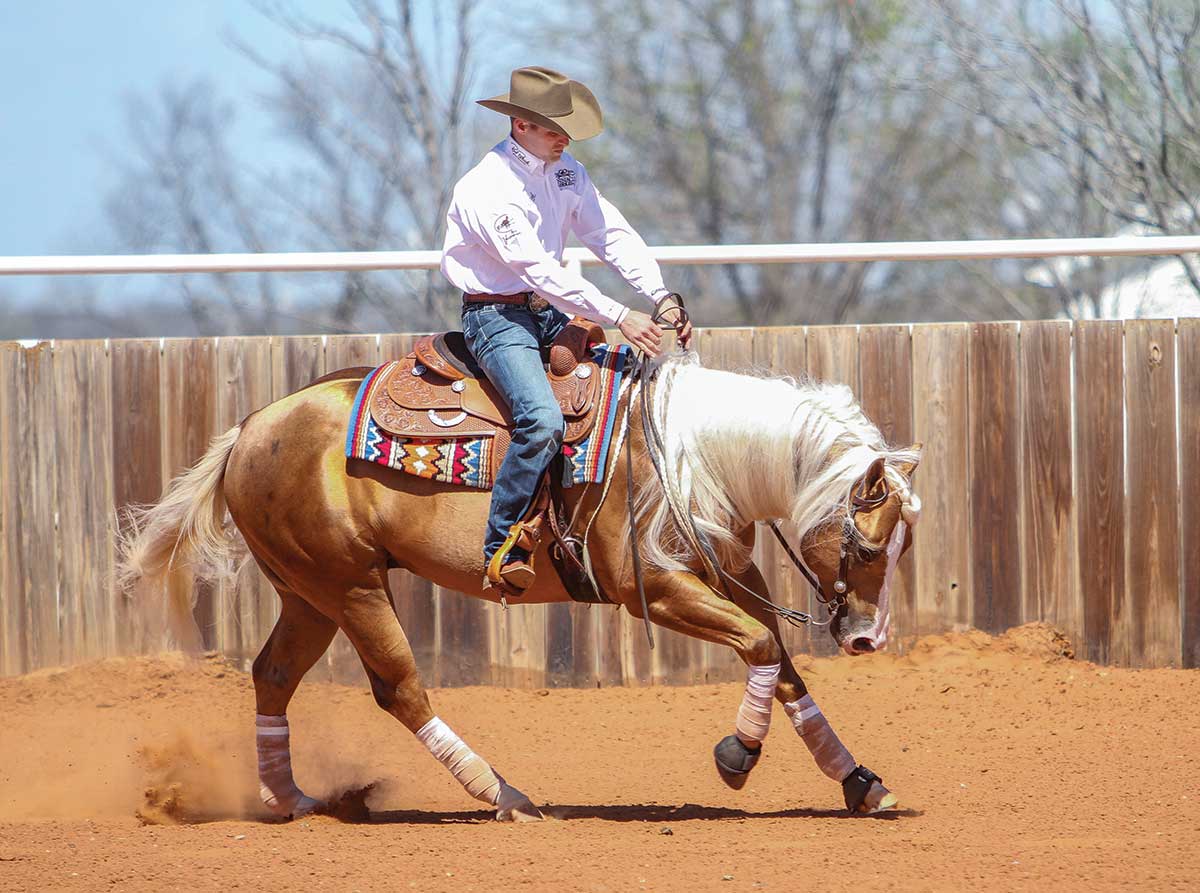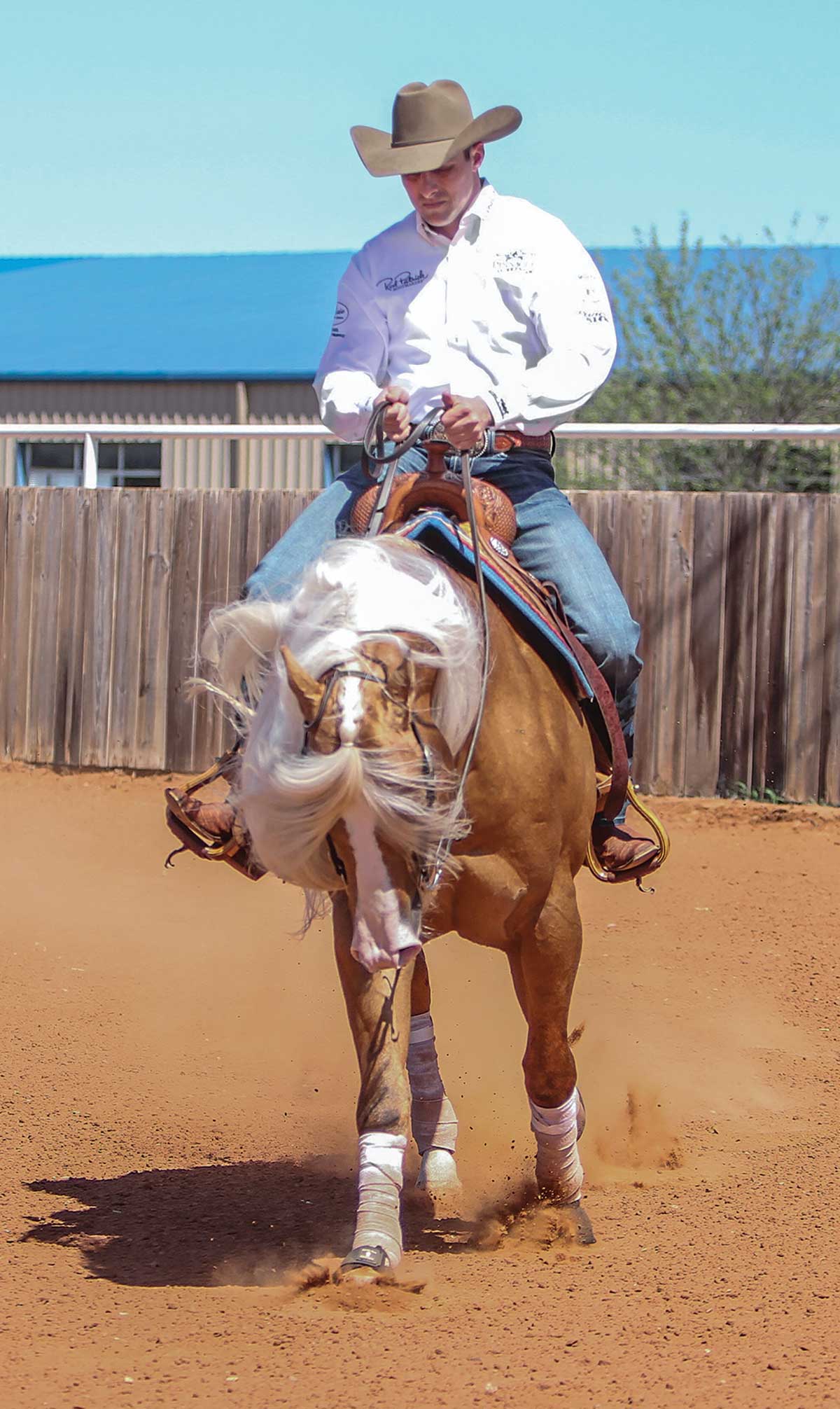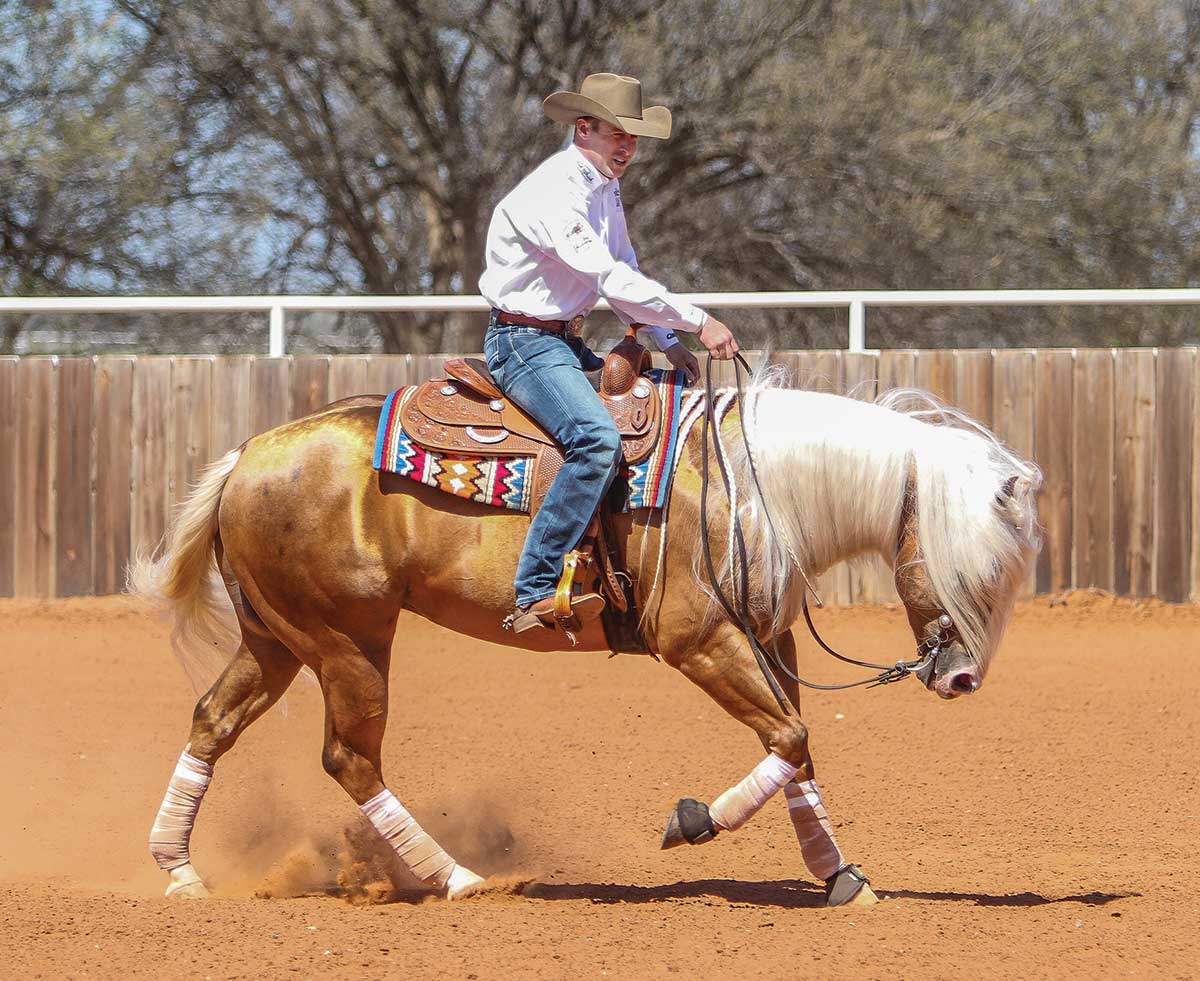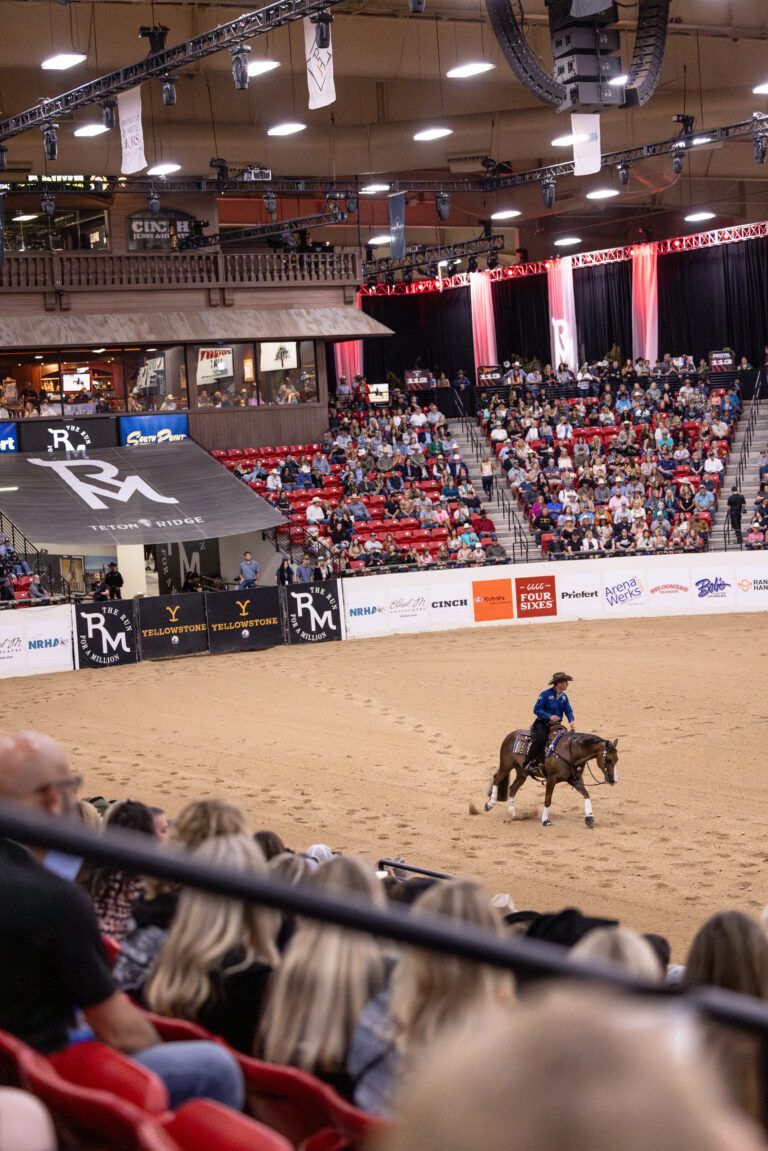
Well-executed speed transitions look effortless in the show pen, but in reality require great effort. It’s a tricky maneuver that can easily put you in the penalty box if you’re not riding each step of the way. Transitioning from fast to slow or slow to fast at the lope requires you to use your legs, seat, and hands together as one unit to keep your horse collected and in the bridle as you shut down or speed up. If you’re out of sync with your horse during a speed transition, you risk swapping leads, stopping, or breaking gait—all of which are penalties in the show arena.
In competition, you’ll see required speed transitions in classes like the reining, ranch riding, and horsemanship. Outside the show pen, working on speed transitions allows you to build confidence as a rider and improves your ability to handle your horse at any gait or speed.
I’ll talk about how to prepare your horse at home for fast-to-slow, and slow-to-fast lope transitions, and in turn increase your score the next time you perform a pattern that involves an increase or decrease in speed.
Leg Before Hand
In a class like reining or horsemanship, you want your hand cues to be subtle and almost unnoticeable. To handle the required transitions, your horse first must willingly guide on your path.
As you ride, look ahead and imagine there’s a circle drawn in the dirt to help you find and stay on your path. Hug your legs to your horse’s sides to guide him and keep him on your desired path. (Note: This doesn’t mean you need to use your spur at all times.) Use your hands as extra guide reinforcement when needed.
If your horse drifts to the outside of your circle, apply more outside leg to push him back in. If he doesn’t understand what you’re asking or isn’t listening, reinforce your correction with your hand, using your leg and hand together to guide him back to the acceptable spot.
This also applies if your horse drops his body into your circle. Keep both legs on your horse, and use more pressure with your inside foot to stop his shoulder from dropping in, get him to stand back up, and steer him back onto your circle. If that doesn’t work, go to your hand and use your inside rein to emphasize the correction.
Once you make your correction, go back to riding with light contact in your hand, and continue to ride with your feet. You want your horse to be comfortable carrying himself without you constantly holding his face.

Build Speed
If you’re new to building speed at the lope, start with two hands, and ride in a bridle that you’re both comfortable working in. You need your horse to stay relaxed as you ask for an increase in speed.
Split your arena in half and ride on one end of the arena to give yourself a large, even circle to work on. The center of your arena will be one end of your circle. In the reining, the center of the arena is the area of your circle where you’ll transition in speed and circle size.
Start by loping on your circle. Once your horse is in good frame and stays collected, ask for a gradual build of speed by pushing your horse forward with your feet. You don’t want to go from zero to 100 in one stride and lose control of your horse. Instead, focus on a smooth, controlled transition that allows your horse to keep cadence in his lope and extend his reach as he builds, rather than have quick, choppy lope strides.
If your horse is new to this speed, stay on your circle, and continue riding him until he’s comfortable going forward and relaxes into the bridle. It may take a few practice sessions before he’s completely relaxed.

Shift Gears
As your horse becomes comfortable going forward, start incorporating your slow down into practice. Think of this transition as a downshift to a slower speed; you want to shift gears to help you naturally slow down rather than pull an emergency brake and get a fast, jerky transition.
Downshifting is a good way to build confidence in your horse’s ability to ace this maneuver and gradually build his ability to slow down in fewer strides once he gets comfortable. When you downshift, your horse is going to stay relaxed and keep cadence in his lope, and it’s also going to help you stay in control of your horse’s body so you can successfully complete the next part of your pattern.
Keep light pressure in your hand, and release your inside leg slowly, as you begin to downshift. Leave your outside leg on your horse so he continues to lope on the correct lead; if you release both legs from your horse at the same time, he may think you’re asking him to stop. As you release that inside leg, sit deeper in your seat and slow the rhythm in your body to encourage a gradual transition.
Plan ahead so you’ve completed your slow down by the time you hit your intended mark. For example, during a reining pattern you want to be shut down when you hit the center of the arena to begin your small circle. This means you want to give yourself at least five or six strides ahead of time to downshift to your regular lope.
Once you’ve mastered shifting gears with your horse, it’s time to increase difficulty in your slow-down. You can start asking for a quicker slow down to hit your required mark, and know that your horse has the confidence to handle that quicker cue without losing position or breaking gait.

Teach the Slow-Down
For a majority of horses, it’s easier to ask for an increase in speed than it is to slow them back down. If you haven’t worked on this transition before, you’re going to have to teach your horse that when you release your inside leg he should gradually slow down to his regular lope.
Start by riding in two hands at a forward lope; ask your horse to come back to a regular lope by releasing your inside leg, while keeping your outside leg on him, and slow the rhythm in your seat. If he doesn’t start to slow down from your leg and seat cue, go to your hands and bring him back to the speed you want. Once he has slowed, release your hands, and continue at a regular lope so he understands that’s the speed he should be going.
The next time you ask for a decrease in speed, release your leg and test your horse. If he doesn’t respond, you can once again follow through with your hand cue to slow him down. If your horse completes the transition from your leg and seat cue, either complete your ride or work on something else to let him know that was the correct answer. You don’t want to overwork this piece in one ride. As you continue to work on your transitions, you can gradually begin to ride one-handed and test your horse’s ability to go from fast to slow in one hand.
Practice Like You Show
You’ve warmed up your horse and he feels great. Then you go into the show arena and start pushing for a faster circle. As you hit the center of the arena you sit down hard and release both legs to slow your horse down, instead of having the “plus” slow-down you’ve worked so hard on at home, your horse swaps lead or stops.
The easiest way to keep total control of your horse’s body, and stay out of the penalty box as you go from a large, fast circle to a small, slow circle, is to ride your horse in the show arena the same way you do at home.
If you change your plan of action as you walk into the show pen, you can’t expect your horse to know what’s coming and stay relaxed. Changing the way you ride your horse after watching other riders in your class puts you at risk of accumulating penalties during your ride because your horse isn’t familiar with how you’re riding him.
If your horse is more sensitive to cues, he might be tight during a transition. This means he likes to slam on the brakes when you ask him to slow down. To prevent that from happening, push him up and keep a steady rhythm in his lope. The next time you ask for your transition, be prepared for a quick response. To avoid that, release your leg a little slower, and don’t sit quite as hard when you start to downshift.
When you’re working with a horse that’s more sensitive to riding cues, stay quiet in your body. If you’re fast in your cue, you’re going to get a fast, jerky response from your horse.
As you incorporate more speed transitions into your riding routine, switch up where you ask him to go forward or slow down. You don’t want your horse to associate one part of the arena as the area where he increases or decreases in speed.
Trevor Dare, Purcell, Oklahoma, is the associate trainer at Xtra Quarter Horses, owned by Silver Spurs Equine. He’s an AQHA world champion, has placed fourth at the NRHA Futurity, and has over $336,000 in lifetime earnings as a professional. Learn more about him at xtraquarterhorses.com.




